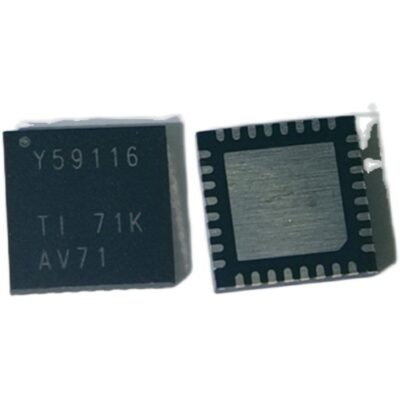TLC59116IRHB
Part Number: TLC59116IRHB
Manufacturer: Texas Instruments
Description: Constant-Current LED Sink Driver
Shipped from: Shenzhen/HK Warehouse
Stock Available: Check with us
ICRFQ.com - Electronic Components Distributor in China Since 2003

Part Number: TLC59116IRHB
Manufacturer: Texas Instruments
Description: Constant-Current LED Sink Driver
Shipped from: Shenzhen/HK Warehouse
Stock Available: Check with us
| Datasheet | |
|---|---|
| Category | Integrated Circuits (ICs) |
| Family | PMIC – LED Drivers |
| Manufacturer | Texas Instruments |
| Series | – |
| Packaging | Tape & Reel (TR) |
| Part Status | Active |
| Type | Linear |
| Topology | – |
| Internal Switch(s) | Yes |
| Number of Outputs | 16 |
| Voltage – Supply (Min) | 3V |
| Voltage – Supply (Max) | 5.5V |
| Voltage – Output | 17V |
| Current – Output / Channel | 120mA |
| Frequency | – |
| Dimming | I2C |
| Applications | Backlight |
| Operating Temperature | -40°C ~ 85°C (TA) |
| Mounting Type | Surface Mount |
| Package / Case | 32-VFQFN Exposed Pad |
| Supplier Device Package | 32-VQFN (5×5) |
The TLC59116 is a 16-channel LED driver by I 2 Devices that is C bus controlled and designed for RGBA color mixing in backlights. 97 kHz is the set frequency of the unique PWM controller for each LED output, and the duty cycle can be adjusted from 0% to 99.6%.
Each LED’s brightness can be adjusted thanks to the PWM controller independently. The duty cycle of the supplementary 8-bit resolution (256 steps) group PWM controller can be adjusted from 0% to 99.6%, and its frequency can range from 190 Hz to once every 10.73 seconds. The group PWM controller applies the same amount of dimming or blinking to every LED. Any given LED output can be turned off, left on (with no PWM control), or given its own PWM controller value.
The TLC59116 can run on power between 3 V and 5.5 V, while its outputs can withstand up to 17 V voltages. The outputs of the TLC59116 chip are suitable for connecting to LEDs. All or defined groups of TLC59116 devices can respond to a shared I 2C-bus address, allowing, for example, all LEDs of the same color to be switched on or off simultaneously or creating a marquee chasing effect while reducing the number of I 2C-bus orders required. Up to 14 devices can share a single bus using only four hardware address pins. In the same way as the Power-On Reset (POR) initializes the registers to their default state, setting the outputs to high, the Software Reset (SWRST) Call lets the master do a reset of the TLC59116 via the I 2C-bus (LED off). Because of this, it is simple and fast to change the settings of all device registers to the same value.
The TLC59116 is a 16-channel LED driver controlled by an I 2C bus and designed for use as a backlight in a mixture of red, green, blue, and amber (RGBA) colors. An independent 97 kHz PWM controller is used for each LED output, with a programmable duty cycle from 0% to 99.6% and a resolution of 8 bits (256 steps).
Each LED’s brightness can be adjusted thanks to the controller’s pulse width modulation capability independently. There is also a group PWM controller with 8 bits of precision (256 steps), a fixed frequency of 190 Hz, and a frequency range of 24 Hz to once every 10.73 seconds, with a duty cycle that may be set anywhere from 0% to 99.6%. The group PWM controller uses the same value to dim or blink all the lights gradually.
The TLC59116 LED has a global overtemperature sensor and 16 overtemperature sensors for each of its 16 channels to detect and shut down the device if either of those temperatures is reached.
An active channel is required for overtemperature error detection. The EFLAG1 and EFLAG2 registers are set when the open-circuit and overtemperature error flags are ORed together. When the host writes 1 to bit 7 of the MODE2 register, it clears the error status code for overtemperature. The overtemperature error flag is enabled when the host writes 0 to bit 7 of the MODE2 register.
After VCC is connected, the TLC59116 remains in reset mode until it reaches VPOR, thanks to an internal power-on reset. Now that the reset condition has been removed, the TLC59116 registers and the I 2C bus state machine have been initialized to their initial states (all zeroes), deselecting all channels. After that, the device can be reset by bringing VCC down to less than 0.2 V.
A reset is achieved by lowering the RESET pin for at least tW. Until the RESET input is made high again, the TLC59116 registers and the I 2C state machine will remain in their initial states. If there is no active connection to this input, a pullup resistor to VCC must be connected.
To sum up, the TLC59116IRHB is an extremely flexible and customizable 16-channel LED driver with independent PWM controllers boasting 8-bit precision and a group PWM controller for coordinating the output of all 16 channels. The group PWM controller enables uniform brightness control or flashing of all connected LEDs. To ensure user safety, the gadget can automatically switch off if it detects the internal temperature is too high. Moreover, there are various hardware and software choices for managing the Lights.
The TLC59116IRHB is a great option for various uses, such as RGBA color mixing and backlighting, because of its high level of control and versatility. ICRFQ is the right supplier for your electronic component needs, with top-quality products and excellent customer service. So, whether you’re working on a personal project or a large-scale application, you can trust ICRFQ to provide the components you need to achieve your goals. Place your order today and experience the difference in quality and service!
WhatsApp us